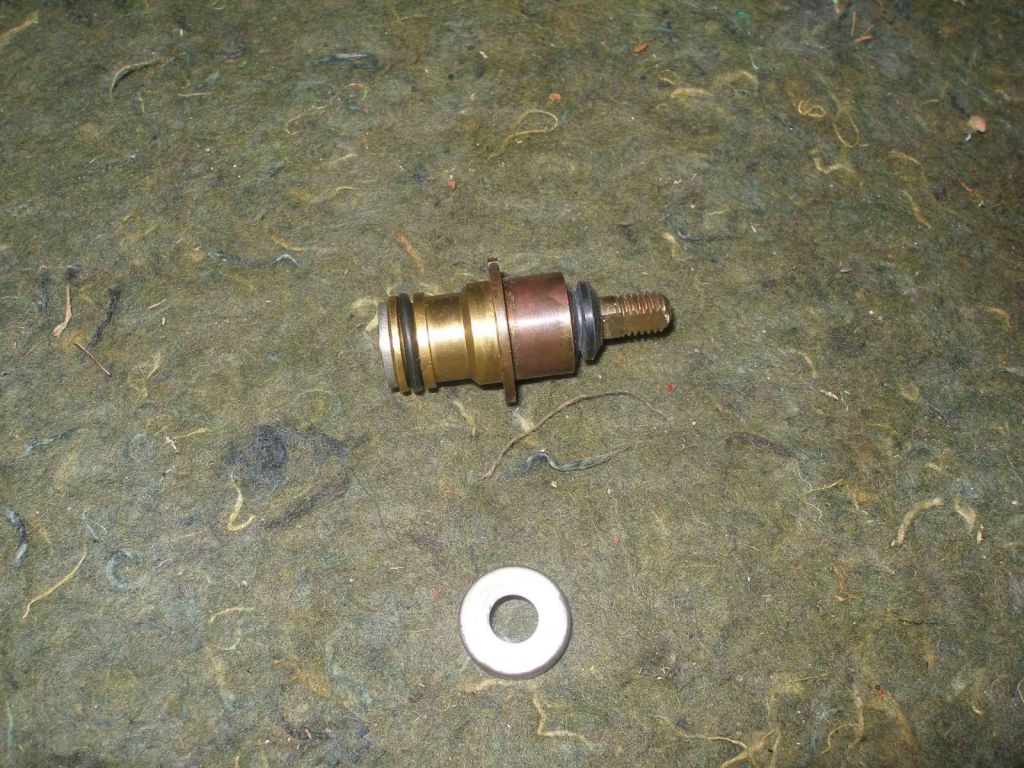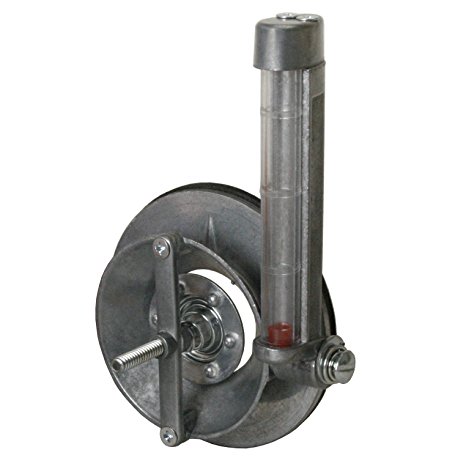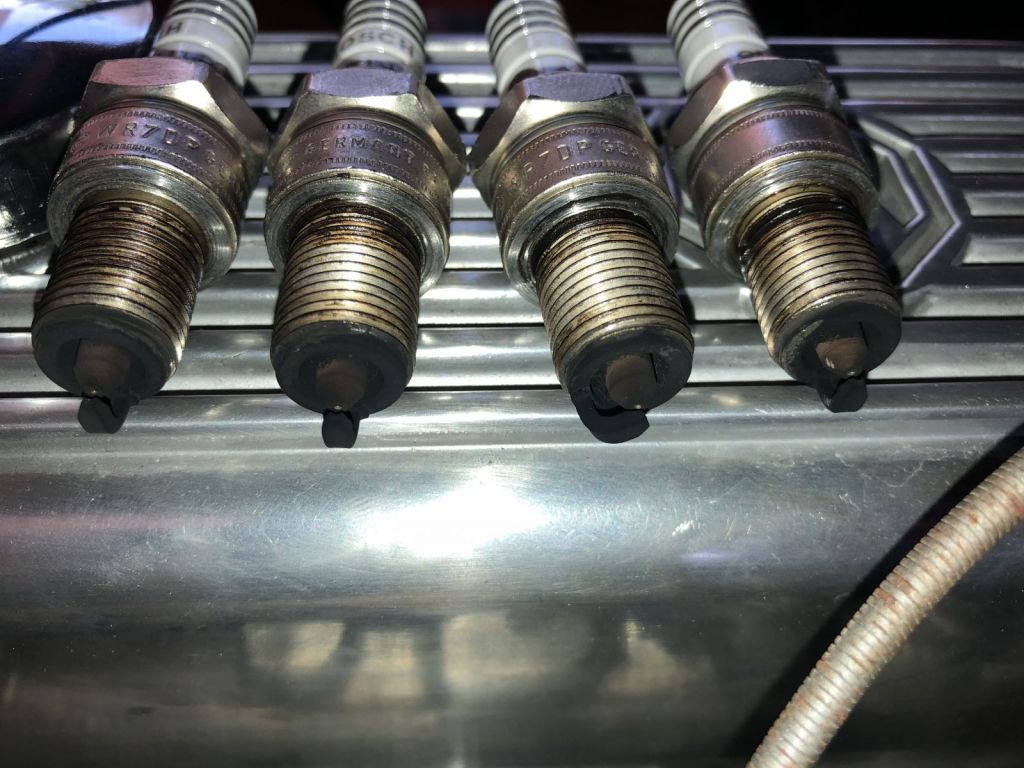en interne un robinet de starter
OUI, comme le dit philoupop, il est possible.
Le starter des HIF en interne , un simple robinet est rendu étanche par 2 joints, celui de l' éxtérieur et l' intérieur. ( cf. photo). Si pour quelque raison, le joint interne fuit, l' essence abonde dans les cylindres, par un cheminement interne à la fonderie du corps de carbu:

De G à D, le joint torique interne sensé étancher les fuites d' essence, le joint "spi" pour étancher les prises d' air.
Un peu de lecture Schekspear-ienne pour vous éclairer:
Practical Classics
6 mai 2014 ·
Anyone who runs twin SU HiF carbs and finds them tough to tune should have a read of this from Barrie Jones. It's the clearest advice I can find.
Fuel System
The fuel system of the MGB is adequately covered in the factory workshop manual, and the choice of carburetter needle and spring seems to be just about right. Later cars are often criticised for an apparent `flat spot’, so it is useful to study the production changes which the manufacturer made to the UK specification engines. (Overseas engines may differ)
Here is my personal interpretation of events:
For many years, SU has offered a range of basic needles as a starting point for anyone developing a new engine. For 1½“ carburetters, these were numbered 1 through 6 (1 being the weakest).
The early MGB used a standard number 5 needle. At a later date, it was found to be a little bit too rich at lower speeds, so a slightly modified needle was produced and given the designation FX.
Around 1971, SU re-designed the HS carburetter, replacing the fixed needles with swinging needles. This gave a more uniform crescent shape to the fuel emission area around the needle, and had the financial advantage of making the jet self-centring, avoiding the time-consuming chore of centring the jet during manufacture. It also had the disadvantage that the needle rubbed against the side of the jet, so they both wore out more quickly. The swinging needle was designated AAF, but the shape of this needle is identical to the FX.
Around 1973 the SU carburetter received a major re-design and was now named HIF (Horizontal with an Integral Float chamber). The AAF needle was still used with this carburetter, and it worked well.
Around 1975 the HIF carburetter body was modified, deleting the vacuum advance pipe. Also, an over-run valve was fitted to each butterfly, allowing extra air into the inlet manifold when the throttle was closed. There were complaints of a slight `flat spot’ during acceleration, so a slightly richer needle was fitted (AAU).
In my opinion, the change of needle from AAF to AAU was based on the assumption that the needle was producing a flat spot. However, the real culprits were (a) the re-positioning of the vacuum pipe, and (b) the over-run valves fitted to the butterflies
On earlier cars, the vacuum for the distributor had been taken from a small drilling, which lined up with the carburetter throttle disc. From 1975 the vacuum pipe was re-positioned onto the inlet manifold. This saved a very high precision manufacturing operation on the carburetter body, but it had the undesirable side-effect of introducing a delay between opening the throttle and the engine responding to that command (i.e. a flat spot). Using richer needles merely masked the problem.
The over-run valves only made the flat spot worse, because they tended to stick partially open, weakening the mixture. Also, when the butterflies are wide open they interfere with the smooth flow of air into the engine, so they are best removed. On 1½ inch carburetters I use the butterflies from an MGA, and on 1¾ inch carburetters I use those from an MGC.
SU Butterflies with and without over-run valve
Around 1977, there was a final change of needle to ACD. This was introduced after a tightening of the UK emissions regulations. Anyone with this setup would be well advised to fit the earlier needles, because the ACD is too weak, especially at speed. I blame these needles for the high incidence of blown head gaskets on post-77 cars.
SU Needle Chart
Here is a comparison chart of all the MGB needles.
Measurements are taken every 1/8 of an inch starting at the shoulder, accurate to 1/10 of one thousandth of an inch. The jets are .090” diameter, so a reading of 890 leaves a circular gap between the jet and the needle measuring only half of a thousandth of an inch. You can see why centring of the jet is so critical.
MGB SU Needles
Position No 5 No 6 FX AAU ACD
(STD) (RICHER) (AAF)
1 890 890 890 890 890
2 850 850 855 850 850
3 814 814 827 828 828
4 785 785 800 806 806
5 758 755 775 780 779
6 733 725 750 745 752
7 705 696 715 710 713
8 680 666 680 675 680
9 653 636 653 647 665
10 627 606 627 620 650
11 600 577 600 590 635
12 590 550 590 560 620
13 580 520 580 530 605
Early Richer Later Swing 18V847
Positions 1-4 correspond to slow speed, and positions 11-13 are for maximum power. The intermediate positions are for mid range and acceleration. The bigger the gap, the richer the needle.
SU Carburetters
The SU carburetter is a very simple device, but it does suffer from wear, and it benefits from regular attention. I recommend that the dashpots are filled with thin engine oil every 1,000 miles, and at the same time a few drops are accurately dripped onto each of the spindle ends and the accelerator linkages. With the engine switched off, it is useful to raise each carburetter piston and listen to the way in which it falls. As the piston drops onto the bridge, there should be quiet a metallic `thunk’. If this distinctive noise cannot be heard, it usually means that the piston is sticking in the dashpot, or the jet has not been correctly centred.
Pistons and Dashpots
Each SU carburetter has a piston and a dashpot. These were selectively assembled as a matched pair, so it is important not to mix the pistons between the two carburetters. There is a timing check that can be made. It involves removing the dashpot and piston, taking out the long spring inside, blocking the vacuum transfer holes in the base of the piston with small corks, and holding the unit upside down. Push the piston fully into the dashpot, and then time how long it takes for the dashpot to fall from the piston (into your spare hand). This should be around 8 – 10 seconds. If one is much faster than the other, perhaps a previous owner has got them mixed up.
Piston Spring
The spring itself is often overlooked. The MGB (and the MGA) had red springs. Other MGs such as the TF had light blue springs, whilst the MG Metro had a yellow spring. This refers to the colour applied to one end of the spring at the factory for identification purposes, using a spirit-based paint. If an MGB is fitted with light blue springs by mistake, the effect will be to give a very weak mixture, whilst a yellow spring will give a rich mixture. The easiest way to check is to place a spring onto kitchen scales and compress it to normal working length. A red spring should read 4 oz but a light blue one should read 2½ oz and a yellow one should read 6 oz.
Centring the Jet
Early MGBs had fixed needles, and the jets on these carburetters must be correctly centred. I find it best to centre the jets off the car.
To centre the jet, the clevis pin at the bottom of the jet must be removed, the choke return spring removed, and the choke bar swung out of the way. Remove the dashpot damper, invert the carburetter, drain it of oil, and then mount the carburetter upside down in a vice. The jet-adjusting nut has a spring underneath it to prevent the adjusting nut from rotating in normal use. This spring must now be removed and the nut replaced, adjusting it up as far as it will go. (Count the number of turns when you remove the nut, and remember this for later reassembly). After this, the large nut that holds the jet assembly under the carburetter must be slackened with a large Whitworth ring spanner. If you do this out of sequence, you will not be able to remove the adjusting nut.
At this point I find it helpful to mount a large screwdriver upside down in the vice, and balance the carburetter on top of it so that the blade of the screwdriver pushes the piston up into the jet. Press the jet fully home, so that the metering needle is forced fully into the jet. This will centre the jet correctly. Whilst holding the carburetter in this position, the large nut can now be re-tightened, after which re-assembly of the carburetter is straightforward.
Float level
For the HS carburetter, the BMC workshop manual recommends a test bar of 1/8” to 3/16” diameter. I normally use a 4mm drill as a checking tool. It should just clear the float when the float chamber lid is turned upside down.
Do not press the float down, or the spring inside the needle will give a false reading. If the float has a metal pivot arm, this can be bent to achieve the correct setting. If the float is all plastic, you can sometimes adjust it by unscrewing the needle valve and adding a fibre washer.
For the HIF carburetter, the recommended float setting is taken at the lowest part of the curve of the float. Check with a steel ruler. There should be 1mm clearance above the bottom edge of the carburetter flange when it is inverted. The metal hinge can be bent to achieve this.
I have recently found a number of porous floats, so this is worth checking. In extreme cases, the float will sink and petrol will pour from the overflow. In less extreme cases, it just sits lower in the chamber and makes the mixture too rich. You can check by holding it up to the light. There should be no fluid inside it.
Whenever you have removed the float lid on an HIF carburetter, ALWAYS fit a new rubber seal on reassembly.
Bi Metallic Strip
I have my suspicions concerning one of the components of the HIF carburetter. The jet is held in a locating bracket, which has a bi-metallic strip built into it. This bi-metallic strip adjusts the mixture to compensate for variations in the temperature of the fuel, and in particular, it weakens the mixture as the engine warms up. My theory is as follows:
The engine compartment of the MGB can get very hot. As it warms, I suspect that the bi-metallic strip can cause over-weakening of the mixture. You stop the car, open the bonnet, release all that hot air, and find that the mixture adjustment is spot-on. But it wasn’t when the car was on the road.
If you couple this with the weak ACD needle, then perhaps it explains the frequency of blown head gaskets on late rubber-bumper cars?
Other problems
With HIF carburetters, there is a secondary jet operated by the choke mechanism. As you pull the choke knob, the jet rotates, so enriching the mixture. This secondary jet has an ‘O’ ring seal, and if the ‘O’ ring fails, the secondary jet then floods the inlet port, giving a very rich mixture. There is no indication from the overflow pipe, so it can be very confusing unless you know about it. I had this problem on my V8, and the symptoms were petrol-soaked spark plugs on the front and rear cylinders of one bank plus the middle two cylinders of the other bank. This corresponds to the shape of the inlet manifold.
Checking the Mixture
You cannot check the mixture setting properly until the engine is thoroughly warmed up. Also, a worn or badly set up engine will make matters more difficult. In particular, the ignition timing and points settings (or dwell angle) should be checked before any carburetter adjustments are attempted.
To check the mixture setting, raise one of the pistons about ¼” slowly - the engine speed should rise and then drop. Raise the other piston, and it should rise and drop by the same amount. If one carburetter rises and stays fast, then it is set too rich. If it falls without first rising, then it is too weak.
Adjusting the Mixture
You cannot adjust the mixture setting properly unless:
• the engine is thoroughly warmed up
• the fuel level is correct in both float chambers
• the choke knob is fully home
• the jet levers have returned to the fully raised position
• the dashpots have sufficient oil in them
It is often possible to adjust the mixture by richening or weakening one carburetter at a time, according to the above test. Adjustment is quite sensitive. The adjusting nut on the HS carburetter has 6 flats on it, and even an adjustment of ½ a flat (30 degrees) can make a noticeable difference, so any adjustments should be made in tiny stages. If you need to make any large adjustments, remember to disconnect the bar connecting the choke levers before you start. You may have to re-adjust its length when you have finished.
For HIF carburetters, the mixture adjustment is via a screw with two slots in it (shaped like a cross). This screw may be hidden behind a tamper-proof plug. For those of you familiar with Weber or Dellorto carburetters, please note that this screw operates ‘the other way round’. You screw it in to richen the mixture. Once again, small adjustments are recommended.
Petrol does contain small amounts of metallic powder and fine sand. You only have to look at the sediment in a float chamber to see this. This abrasive powder will eventually wear the jets. As they get larger, they pass more fuel. This causes a rich mixture, so the jet must be raised to compensate. Eventually, the jet wears so much that it reaches the limit of adjustment - it nearly touches the shoulder on the needle. At this point, it becomes impossible to adjust the carburetters correctly, and I have seen experienced mechanics `tearing their hair out’ because they just can’t get it right. Once this condition has been reached, it is best to fit two new jets and two new metering needles. Swinging needles seem to wear out much more quickly than fixed needles.
Adjusting the balance
Once you have got the mixture right, then you can then check the balance. If one carburetter seems to have a larger effect than the other, then the tickover settings are not identical, so undo one of the links between the throttles, adjust the tickover screws until they are as similar as possible, and then re-tighten the linkage. Alternatively, with the air filters removed, you can use a length of rubber fuel hose. Place one end just inside the mouth of each carburetter in turn, and listen to the other end. You can clearly hear whether the engine is sucking the same amount of air through each carburetter, and this is a more accurate method of balancing.
https://www.facebook.com/PracticalClass ... 5786106044







